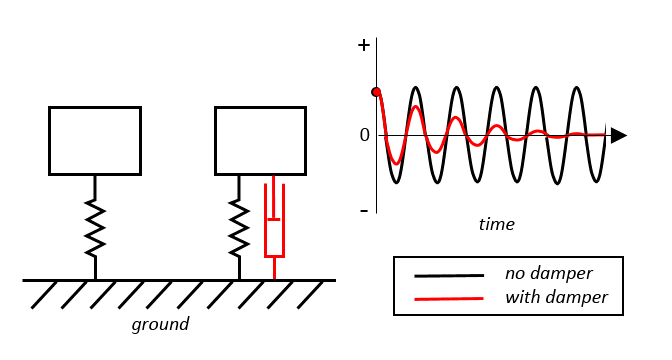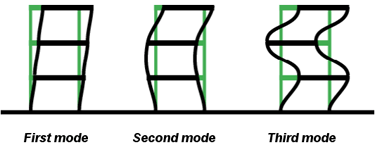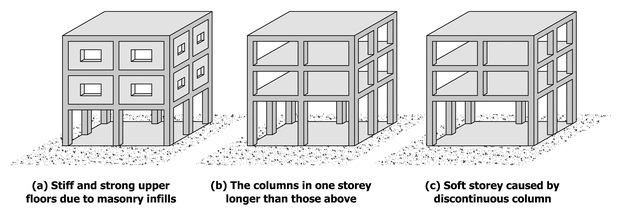In this article, we explain the important terminology for analysis and design of earthquake resistance structure such as what is damping, Liquefaction, Natural Time Period, Center of Mass, Center of Resistance, Diaphragm, Model Mass, Modes Shape, OMRF, SMRF, Soft Storey, Storey Drift, Importance factor, etc.
At the end, if you got any value from this article than please share with your friends because sharing is caring. Before starting the article, I clarify you that, This whole article is related to earthquake resistance design of structure and base on Indian Standard IS1893 – Part 1 (2016).
Table of Contents
Important Definition for Design of Earthquake Resistance S
What is Damping in structure?
Damping in structure is a dissipation of energy due to effect of internal friction, inelasticity of material, slipping, sliding, movements, etc.

Majorly, damping is divided in two parts. Inherit Damping and mechanical or supplement damping.
Inherent damping is a effect of structural property such as material elasticity and bonding, friction, slipping, sliding between members, etc. which dissipate the energy (reduction of amplitude of oscillation).
While, Supplement damping in structure is defined as a additional mechanical system such as viscous or tuned mass damper, etc. fitted in structure to dissipate the energy and oscillation of structure.
Also Read: Tuned mass damper – Purpose | Case study of Taipei TMD
What is Liquefaction?

Soil Liquefaction is a phenomena in which soil effective shear strength is reduced to negligible value by earthquake shaking. In this state, soils tend to behave like a fluid.
Mostly, Soil liquefaction is happen in sandy soil due to earthquake shaking. During earthquake, the water held by voids of sandy soil is rise up due to shaking and exert high pressure on soil to get liquified. Results, soil loose its shear strength and behave like a fluid.
What is Natural Period of structure?
Natural Period of structure is defined as a time taken by a structure to complete one cycle of oscillation.
What is Center of Mass in structure?
Center of mass in structure is defined as a point in floor of building through which resultant of inertia force of that floor is considered to act during earthquake shaking.
What is Center of resistance in structure?
Center of resistance or center of rigidity is a centroid of stiffness of structure located at in floor. It is a point at which inertia force act during earthquake, than floor experience only the translation displacement.
If inertia forces not act on center or rigidity that means center of mass and center of rigidity is not on a same point than structure experience the rotation on torsion during earthquake.
The distance between Center of mass and Center of rigidity is know as a eccentricity.
Also Read: Criteria for SBC & Types of Soil as per IS:1893
What is Diaphragm in structure model?
Diaphragm in structure is defined as a horizontal structural system such as reinforced concrete floor, horizontal bracing system, etc. which transfer the lateral force to the vertical structural member connected to it.
What is Mode of Oscillation in seismic design?
It is a part of the total seismic mass of the structure that is effective in natural mode of oscillation during vertical and horizontal ground motion.
What is Mode shape?
Mode shape is deflection pattern of the structure at a particular natural frequency.

What is Mode of Oscillation?
Mode of oscillation is defined as a oscillation in which all points of structure oscillate harmonically at the same frequency and reach their individual maximum responses simultaneously.
Also Read: Ductile Detailing of Column as per IS 13920-2016
What is Ordinary Moment resisting Frame (OMRF)?
Ordinary moment resisting frame is a moment resisting frame which is designed and detailed as per Indian standard IS:456 and IS:800, but not meeting any special detailing requirement for ductile behavior as per IS:13920.
What is Special Moment resisting Frame (SMRF)?
Special moment resisting frame is a moment resisting frame which is designed and detailed as per Indian standard IS:456 and IS:800, and meeting special detailing requirement for ductile behavior as per IS:13920.
Also Read: Ductile Detailing of Beam as per IS 13920-2016
What is Soft Storey?
Soft storey is defined as a storey which lateral stiffness is less than the above storey.

What is Storey Drift?
Storey drift is defined as a relative displacement of the floor between above and below of the considered storey.

What is Importance factors in seismic design?
Importance factor is a constant value recommended by the Indian standard that is used to increase the seismic load based on importance of structure. For example, Importance factor is 1.5 for Hospital, School, Metro station, telephone station, etc. and it is 1.2 for Residential and other moderate important building.
Also Read: Different types of load on Building


Thanks for the blog loaded with so much information. It’s really informative.
Earthquake Resistance Properties of AAC Blocks